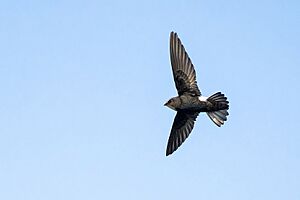House swift facts for kids
Quick facts for kids House swift |
|
|---|---|
 |
|
| In flight at Shivapuri Nagarjun National Park, Nepal | |
| Conservation status | |
| Scientific classification | |
| Genus: |
Apus
|
| Species: |
nipalensis
|
The house swift (Apus nipalensis) is a species of swift in the family Apodidae. It is found in Japan, Nepal, and Southeast Asia. It is capable of flying long distances by alternately shutting off hemispheres of its brain in-flight.
It was formerly considered a subspecies of the little swift, under the name Apus affinis subfurcatus.
Contents
Description
The house swift looks quite similar to the little swift. It is a small bird, but a medium-sized swift, with a wingspan of 12.5-14.5 cm. Its body size ranges from 14 to 16 cm and weighs approximately 20-35 g. This species has a dark, slightly forked tail. Other than the white rump band and white throat-patch, the house swift has a black plumage, darker than the little swift.
Taxonomy
The name Apus nipalensis has two parts. Apus is the genus for swifts, and comes from the Latin word for the swift, or swallow with no feet. Nipalensis means from Nepal.
Currently, there are four subspecies of the house swift: Apus nipalensis nipalensis, Apus nipalensis subfurcatus, Apus nipalensis furcatus, and Apus nipalensis kuntzi.
Habitat and distribution
The house swift is highly aerial, spending much of its time feeding in the air. The house swift is generally found on the Asian continent. Each subspecies has a slightly different distribution throughout the continent.
- Apus nipalensis nipalensis occupy the area from Nepal to Southeastern China, Japan, and parts of Southeast Asia
- Apus nipalensis subfurcatus are in the Malay Peninsula and other islands in Southeast Asia.
- Apus nipalensis furcatus are on Java and Bali in Indonesia.
- Apus nipalensis kuntzi solely occupy the island of Taiwan.
House swifts live both in urban and rural areas of Asia. They've been found from the mountainous regions of Nepal and in cities and towns in China, Vietnam, and Hong Kong. It has been found in North America only one time in 2012; it was identified as a house swift after DNA sequencing. However, this observation was unaccepted as the bird was dead when found.
Behavior
House swifts have two main areas of nesting: in cliffs or in urban areas. When nesting in urban areas, this species tends to prefer under roof overhangs of buildings or in tunnels. Many nest in cliffs on offshore islands near Vietnam. House swifts build their nest using their saliva to messily stick together leaves, branches and feathers.
Reproduction
The house swift has one breeding period with, generally, two broods per year. The first egg-laying period takes three weeks. By early June, all fledglings from the first clutch have taken flight. A few weeks later, the second clutch hatches. The last fledglings leave the nest by mid-September. The clutch sizes can vary, ranging anywhere from one to five eggs. The incubation period can last anywhere from 20 to 30 days.
Diet
Like many swallows and swifts, house swifts eat in the air. They mainly feed on small organisms that are dispersed throughout the air. A fecal analysis discovered the house swift diet is almost solely from the arthropoda phylum. This primarily includes, but is not limited to, ants, spiders, mosquitos, and flies.
Vocalizations
House swifts make a ti-ti-ti-tititrrrrrr sound, among many others, as part of their vocal catalogues.
Migration
Not much research has been done specifically on the migration of house swifts. They have been recorded in Northern Australia and India, indicating some sort of movement during winter.


